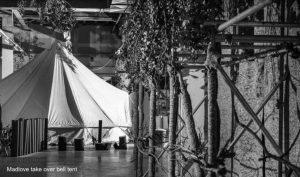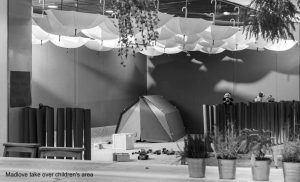Artist and mental health activist the vacuum cleaner (AKA James Leadbitter) explains what he has been (mostly) doing for the last five years of the Madlove project he has been leading on.
It began, as all good things often do, in a moment of madness. What if the places we need to feel safe, to experience our pain and be mad were actually designed and run by us mad people? With us and for us ‒ with the help of our allies.
Having been in plenty of not very good mental health hospitals I knew something had to change. In 2013 I formulated a plan, a project called Madlove: A Designer Asylum. (Designer ‒ because we deserve luxury, and Asylum ‒ because we need safe places.)
The Original Proposition
It ain’t no bad thing to need a safe place to go mad. The problem is that a lot of mental health hospitals are more punishment than love… they need some Madlove.
Is it possible to go mad in a positive way? How would you create a safe place in which to do so? If you designed your own asylum, what would it be like?
Madlove creates positive spaces to experience mental distress… and enlightenment. The project is bringing together people with and without mental health experiences, mental health professionals and academics, artists and designers – and everyone else on the spectrum.
The aim is to build the most crazy, bonkers, mental asylum we dare dream of: a desirable and playful space to ‘go mad’, countering the popular myth that mental health is dangerous and scary. Together we are attempting to create a unique space where mutual care blossoms, stigma and discrimination are actively challenged, divisions understood, and madness can be experienced in a less painful way.
Madlove is not the lunatics taking over the asylum, we are proposing that we should design, build and run the asylum too. This significant mutual care project invites people to share knowledge, experience and to openly support and inform each other.
Through Madlove, we can begin to understand the power relations between patient and staff, lived expert and academic expert, artist and audience, neuro-diverse and neuro-typical… and start making positive change.
It’s time to put the treat back into treatment.
It’s all about the process motherfuckers.
Since making this proposal we have run workshops in over 25 places around the UK and internationally ‒ from fancy pants art centres to children’s wards, from high security hospitals to community spaces. From Ireland to Indonesia. We’ve listened to over 500 people with lived experience, people from the mental health industry, carers and allies. We have met some INCREDIBLE people, with the most horrid stories, who have been able to turn those into the most compassionate, thoughtful and generous ideas. People that have, as one person told me in Ireland a few weeks ago with a beaming smile on her face ‘been thinking about the best mental health hospital in the world for 30 years, it’s just that no one bothered to ask me… until now.’
We have mostly asked the same questions…. such as:
- What does good care feel like? (emotionally)
- What does good mental health sound, look, smell, taste and feel like to touch?
- What are the qualities of the people around you for good mental health?
And:
- If you could design your own asylum, what would it be like? ‒ what activities and features would be in the perfect environment?

What have we heard?
Well it’s an extensive list… and impossible to represent everything, to find the words for some of the feelings, or translate some things specifically into English. I remember a particular moment in a workshop at the House of Empowerment, a radical art and mental health space in Indonesia, that will always be lost as the translator insisted ‘English just isn’t a good enough language to describe what he is saying’.
But broadly we have noticed common and recurring themes. This is totally not surprising… and even more unsurprisingly, the exact opposite of what most people get from health services. (Though we have met some amazing people doing amazing stuff and been to some hospitals that were pretty good ‒ to be fair).
Anyway, what are the key takeaway points?
That care should be empowering, flexible and on a human scale. Led by us, and easily accessible.
That spaces should be stimulating, with both loud music and silence, look like real natural landscapes ‒ mountains, the sea and the stars. Smells should be calming and linked to positive memories. The taste should be both super healthy and deliciously unhealthy. And to touch, lots of natural fibres, hugs, and animals to cuddle.
The people that work there should be tender, funny, available, calm, with lived experience, good work-life balance and, perhaps obviously, able to really listen.
Hospitals/safe places/ community spaces should be deeply rooted in nature: gardens, forests, mountains and water. There should be plenty to do ‒music and art workshops, cinemas, farms, spas and rooms of faberge eggs and hammers. They should be sites that offer a range and spectrum of designs, aesthetics and experiences, which can be adapted to our specific states at different points on our journeys. Think music festival, with all its different zones for different experiences. Just without the mud and drunk people.
From dreams to reality
Our project hasn’t just been research focused. It has equally been about how to inspire and make real-world changes.
We’ve done this in two main ways.
Firstly ‒ through exhibitions, community spaces, talks and the media we have shared examples of what this research could be like. We’ve made a temporary community space at FACT gallery in Liverpool, a model hospital for Bedlam: Asylum and Beyond, and a play-based sculpture made with children from Great Ormond Street Hospital’s CAMHS ward for the permanent exhibition Being Human at the Wellcome Collection, London. Most recently, we created a large-scale community space in St Helens which included a 7 metre ‘together table’, a care cafe, children’s play area, a chill out tent, a community workshop space and theatre/cinema all designed to feel like it was in a forest, smelling of lavender, open 11 to 6 five days a week and free for everyone.
Using the press and talks we’ve reached a truly globally audience with positive ideas about what mental health care could be like.

Secondly ‒ we’ve been able to put this research into practice in NHS settings. We’ve supported architects from Projects Office to create a radical and beautiful new CAMHS ward at the Royal Hospital for Sick Children, Edinburgh. We’ve worked with patients at Broadmoor Hospital to create pavilions for the new courtyard that connect the men to nature. And currently I am helping to write the brief for the new CAMHS ward at Great Ormond Street Hospital for Children having spent 6 months listening to the needs of the young people and staff from this ward.
Holding a utopian position to drag along the mainstream; working within the mainstream with a utopian position
For many in radical mental health activism and lived experience ‘worlds’, our project may seem obvious, and that’s because it is. Really bloody obvious. If you have lived experience, like me, you know you are mad, not stupid.
The mainstream is not so smart. Many times, I get the feeling that both the mental health industry and wider public confuse psychological pain and stupidity. Which is, of course, a bit stupid. :-).
Changing mainstream mental health care is slow and complex. It has held onto power for a very long time, 100s of years. And like most institutions of power, it doesn’t want to give that power up. So we (mad people and our allies) need to continue to take over the means of production, whilst defending the rights of each other ‒ which is a LOT of work. This is made more complex by our lived experience. We have fluctuating disabilities, it’s hard to meet regularly in person, we can experience rage, anxiety, depression and paranoia. So we must approach this change slowly and sustainably.
We will have to engage with the mainstream because it holds all the cards, but that doesn’t mean we shouldn’t dream, imagine and demand justice. Mental health justice for ourselves, our fellow survivors and those who will experience distress tomorrow.
Utopia is a process, not an end point. See you there.
See more on ‒ thevacuumcleaner.co.uk
Shout out to: Hannah Hull, Emily Gee, Pam ‘the’ Vision’, Caroline Moore @ GOSH Arts Projects Office, muf Architecture/Art and the 500 plus people who have lovingly shared their ideas.
This is a sample article from the Spring 2020 issue of Asylum magazine
(Volume 27, Number 1)
To read more . . . subscribe to Asylum magazine.
